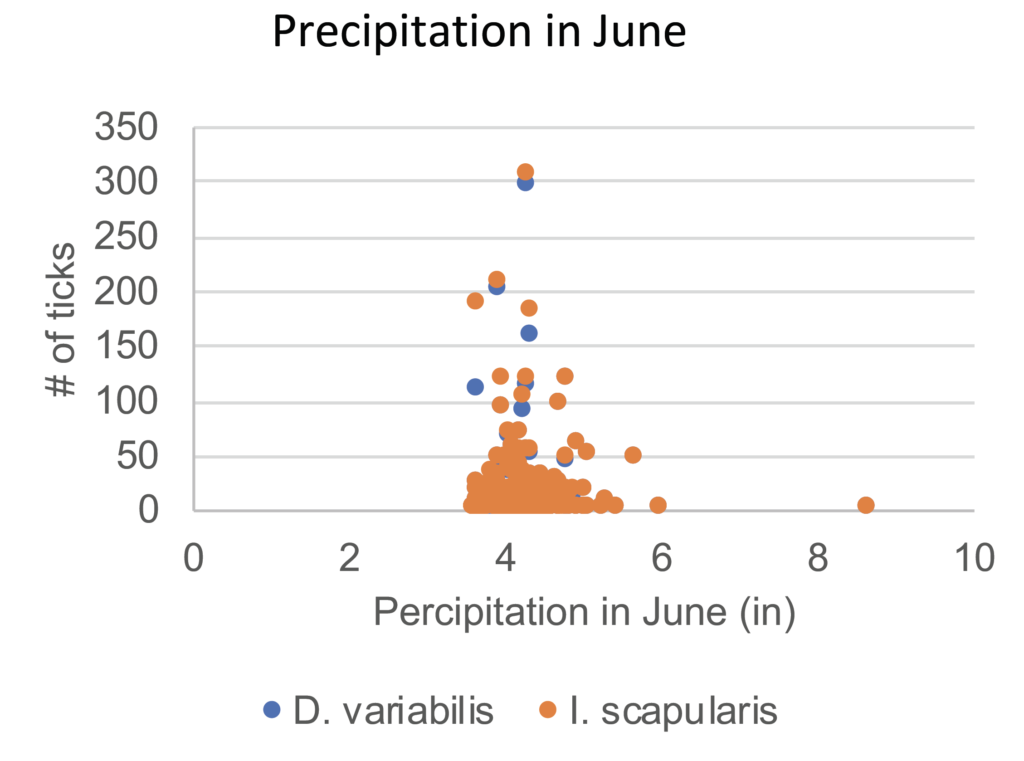OUR DATA FOR TICKS IN OUR AREA
The following charts show some of our data from collecting, identifying, and tracking areas with heavy tick populations and tick-borne diseases. We will be routinely updating this page with new data and charts as our research develops.
View maps of ticks and disease on our Mapping Ticks page →
For more information, see our Newsletters page →
2021 DATA



BeBop Labs collects most of its ticks from New Hampshire, but we have access to other states as well. We see a consistent and significant amount of ticks from year to year.


In New Hampshire, we see 50% less blacklegged (deer) ticks than dog ticks. Blacklegged ticks can carry Lyme disease. NH does have some Lone Star ticks (7 ticks collected in the past 4 years).


Out of over 2,500 Blacklegged ticks (aka deer ticks) tested, 38% carried pathogens from the genus Borrelia, which is the bacteria that causes
Lyme Disease.
2020 DATA


There is only 1 season for Dog ticks
- Spring-summer
- Peaks in June
There are 2 seasons for Blacklegged ticks (aka BLT and Deer ticks):
- Spring season peaks in May
- Fall season peaks in October
- We see BLT as early as March


Collected nymphs were mostly disease free, with about equal amounts of adults contained disease as didn’t.


Dog ticks peaked in June and Blacklegged (deer) ticks peaked in May and October, corresponding with peaks of Lyme disease and somewhat anaplasmosis.


Spring and fall are the seasons in which we find the most percentage of ticks co-infected.
Are There More Blacklegged Ticks in North or in South NH?
It appears there are more Blacklegged (deer) ticks in the southern part of the state than Dog ticks.
There is possibly no correlations with tick species and elevation, slope, precipitation and land cover, yet all data is not included, and statistical analysis has yet to be performed.










2019 DATA
In 2019, we collected 5,820 ticks. We tested 1,272 of those for disease.


WHAT TIME OF YEAR DO YOU FIND TICKS?




What time of year do you find ticks?
There is only 1 season for Dog ticks:
- Spring-summer
- Peaks in June
There are 2 seasons for Blacklegged ticks (aka BLT and Deer ticks):
- Spring season peaks in May
- Fall season peaks in October
- We see BLT as early as March
WHAT TIME OF YEAR ARE MOST BLACKLEGGED TICKS (DEER TICKS) INFECTED WITH DISEASE?


There is a higher percentage of infected BLT in the fall than the spring. This conclusion is made excluding the information gathered January—March as numbers of ticks are so low.
WHAT TIME OF YEAR DO WE FIND TICK BORNE DISEASES IN NH?*
From analyzing 2018 data we made the conclusion that tick-borne diseases are steady all year round as we were unable to see a pattern in the data. Yet, when we combine our disease data from 2018 with 2019 we see that Lyme disease and Anaplasmosis has 2 seasons coinciding with the BLT seasons. Ticks harboring Babesiosis are higher in the spring, but the data could be too small to make definitive conclusion. And ticks that carry Miyamotoi have no noticeable patterns yet.


AT-RISK ACTIVITIES FOR HUMANS


The highest at risk activity for biting ticks is gardening/ yard work and the highest at risk activity for a crawling tick is walking/ hiking.
ARE THERE MORE BLACKLEGGED TICKS (AKA DEER TICKS) SOUTH OF CONCORD THAN THERE ARE NORTH?




Because BeBop Labs crowdsources for ticks we normalized our data by creating a ratio of BLT to Dog ticks. We analyzed the ratios by NH county to maximize the numbers of ticks. By doing this we can see that Rockingham and Hillsborough counties have more BLT as compared to Dog ticks, ratios greater than 1. Belknap, Carroll, Coos, Grafton, Merrimack county have more Dog ticks than BLT, ratios less than 1. Cheshire, Strafford and Sullivan ticks are in between, we may need more data as the data is inconsistent from 2018 to 2019.
2018 DATA
In 2018, we collected 1,654 ticks, 822 were tested for disease. Of which 100 were tested and funded by BeBop Labs personal funds. There were 554 BLT and 1,100 Dog ticks. Thank you for saving and sending us ticks and data. Check out what we learned from your data below.
WHEN DO YOU FIND TICKS?
There are 2 seasons for BLT: Spring and Fall. Most dog ticks are found in the Spring. So don’t be fooled in the Spring by pesky dog ticks, look carefully for those BLT when you check yourself for ticks. Check out our data below for the evidence.
WHEN DID WE FIND TICKS IN 2018?


NUMBER OF TICKS FOUND IN SPRING 2018


WHEN DO WE FIND TICK-BORNE DISEASES IN NH?
Despite having 2 seasons for disease carrying BLT, the Tick-borne diseases are steady all year round! Check out where we find disease, under out mapping ticks and disease page.
WHEN DO WE FIND TICK-BORNE DISEASES IN NH?


TICK BEHAVIOR INFORMATION
Look below at the different behaviors ticks have.
Female ticks like to bite more than male ticks. Many more female BLT bite. Females need a blood meal so they can lay eggs. All ticks need blood to “level up” to their next stage of growth.
NUMBER OF DOG TICKS BITING OR CRAWLING, NORTH OF CONCORD (LAT 43.3), SPRING 2018


NUMBER OF BLACK LEGGED (DEER) TICKS BITING OR CRAWLING NORTH OF CONCORD (LAT 43.3), SPRING 2018


